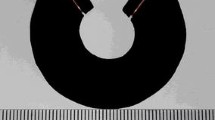Abstract
Magneto-acoustic imaging is a novel functional imaging method to electrical characteristics of tissue. It provides valuable tools for diagnosing early stage tumor and monitoring bioelectrical current. Common single short-pulse excitation limits SNR due to the short-pulse duration and low power of magneto-acoustic signal. In this study, we propose M-sequence-coded excitation and pulse compression approach to improve SNR of magneto-acoustic imaging. Simulations on the magneto-acoustic signal under different bit lengths M-sequence-coded excitation are performed. Experiments on the samples made of pork and graphite slices are done to validate the proposed coded excitation method. The SNR and sidelobe levels were investigated. The results showed when 7, 15, 31, 63, 127 bits M-sequence-coded excitations were applied onto the samples, SNR was improved by 17.4 dB, 24.2 dB, 30.6 dB, 37.6 dB, and 40.1 dB, respectively. For a similar SNR improvement, the total used time under coded excitation can be shortened to 9.4% under the single pulse excitation. The result indicates the M-sequence-coded excitation approach is effective to improve the magneto-acoustic signal SNR and shorten the imaging time.

SNR of the magneto-acoustic signal is significantly improved by the coded excitation than the pulse excitation, the reconstructed image of the front and back boundary of the pork can be seen clearly under the 7, 15, 31, 63, 127 bit M-sequence-coded excitations.








Similar content being viewed by others
References
Roth BJ (2011) The role of magnetic forces in biology and medicine. Exp Biol Med 236(2):132–137
Emerson JF, Chang DB (2013) Electromagnetic acoustic imaging. IEEE Trans Ultrason Ferroelectr Freq Control 60(2):364–372
Haemmerich D, Schutt DJ, Wright AW, Webster JG, Mahvi DM (2009) Electrical conductivity measurement of excised human metastatic liver tumours before and after thermal ablation. Physiol Meas 30(5):459–466
Gabriel S, Lau RW, Gabriel C (1996) The dielectric properties of biological tissues: II. Measurements in the frequency range 10 Hz to 20 GHz. Phys Med Biol 41(11):2251–2269
Surowiec AJ, Stuchly SS, Barr JB, Swarup A (1988) Dielectric properties of breast carcinoma and the surrounding tissues. IEEE Trans Biomed Eng 35(4):257–263
Towe BC, Islam MR (1988) A magneto-acoustic method for the noninvasive measurement of bioelectric currents. IEEE Trans Biomed Eng 35(10):892–894
Bradley JR, Basser PJ, Wikswo JP (1994) A theoretical model for magneto-acoustic imaging of bioelectric currents. IEEE Trans Biomed Eng 41(8):723–728
Aliroteh MS, Scott G, Arbabian A (2014) Frequency-modulated magneto-acoustic detection and imaging. Electron Lett 50(11):790–792
Wen H, Shah J, Balaban RS (1998) Hall effect imaging. IEEE Trans Biomed Eng 45(1):119–124
Leo M, Hu G, He B (2014) Magnetoacoustic tomography with magnetic induction for high-resolution bioimepedance imaging through vector source reconstruction under the static field of MRI magnet. Med Phys 41(2):131–134
Yu K, Shao Q, Ashkenazi S, Bischof JC, He B (2016) In vivo electrical conductivity contrast imaging in a mouse model of cancer using high-frequency magnetoacoustic tomography with magnetic induction (hfMAT-MI). IEEE Trans Med Imaging 35(10):2301–2311
Li X, Yu K, He B (2016) Magnetoacoustic tomography with magnetic induction (MAT-MI) for imaging electrical conductivity of biological tissue: a tutorial review. Phys Med Biol 61(18):R249
Graslandmongrain P, Mari JM, Chapelon JY, Lafon C (2014) Lorentz force electrical impedance tomography. IRBM 34(4–5):357–360
Zhang S, Zhou X, Yin T, Liu Z (2017) Magneto-acoustic imaging by continuous-wave excitation. Med Biol Eng Comput 55(4):595–607
Zhang S, Zhou X, Ma R, Yin T, Liu Z (2015) A study on locating the sonic source of sinusoidal magneto-acoustic signals using a vector method. Biomed Mater Eng 26(s1):1177–1184
Renzhiglova E, Ivantsiv V, Xu Y (2010) Difference frequency magneto-acousto-electrical tomography (DF-MAET): application of ultrasound-induced radiation force to imaging electrical current density. IEEE Trans Ultrason Ferroelectr Freq Control 57(11):2391–2402
Zhang S et al (2018) Research on barker coded excitation method for magneto-acoustic imaging. Biomed Signal Process Control 39:169–176
Colone F, Falcone P, Bongioanni C, Lombardo P (2012) WiFi-based passive bistatic radar: data processing schemes and experimental results. IEEE Trans Aerosp Electron Syst 48(2):1061–1079
Jibiki T (2001) Coded excitation medical ultrasound imaging. Jap J Med Phys 21(3):136–141
Golomb SW, Gong G (2005) Signal Design for Good Correlation: For Wireless Communication, Cryptography, and Radar. Cambridge University Press, U.K, pp 117–161
Xu Y, He B (2005) Magnetoacoustic tomography with magnetic induction (MAT-MI). IEEE Trans Med Imaging 29(10):3173–3176
Hinich MJ (1962) A model for a self-adapting filter. Inf Control 5(3):185–203
Fu J, Wei G, Huang Q, Ji F, Feng Y (2014) Barker coded excitation with linear frequency modulated carrier for ultrasonic imaging. Biomed Signal Process Control 13(1):306–312
Pye SD, Wild SR, Mcdicken WN (1992) Adaptive time gain compensation for ultrasonic imaging. Ultrasound Med Biol 18(2):205–212
Marcolin MA, Padberg F (2007) Transcranial brain stimulation for treatment in mental disorders. Adv Biol Psychiatry 23:204–225
Feng X, Gao F, Kishor R, Zheng Y (2014) Coexisting and mixing phenomena of thermoacoustic and magnetoacoustic waves in water. Sci Rep 5:1–10
Mariappan L, Li X, He B (2011) B-scan based acoustic source reconstruction for magnetoacoustic tomography with magnetic induction (MAT-MI). IEEE Trans Biomed Eng 58(3):713–720
Benedetto J, Konstantinidis I, Rangaswamy M (2009) Phase-coded waveforms and their design. IEEE Signal Process Mag 26(1):22–31
Yu M, Zhang C, Yu G (2014) Research on a new waveform based on MAC sequence. In: 2014 IEEE International Conference on Signal Processing, Communications and Computing (ICSPCC), Guilin, China, AUG, pp 456–460
Rihaczek AW, Golden RM (1971) Range sidelobe suppression for Barker codes. IEEE Trans Aerosp Electron Syst 7(6):1087–1092
Acknowledgements
Z Liu would like to thank Dr. Cheng Yi for his assistance in editing the language of this manuscript.
Funding
This study was supported by the Grants from the National Natural Foundation of China (61501523, 81772004), CAMS Initiative for Innovative Medicine (2017-I2M- 3-020), and National Natural Foundation of Tianjin (17JCZDJC32400).
Author information
Authors and Affiliations
Corresponding author
Rights and permissions
About this article
Cite this article
Zhang, S., Ma, R., Yin, T. et al. M-sequence-coded excitation for magneto-acoustic imaging. Med Biol Eng Comput 57, 1059–1067 (2019). https://doi.org/10.1007/s11517-018-1941-x
Received:
Accepted:
Published:
Issue Date:
DOI: https://doi.org/10.1007/s11517-018-1941-x




